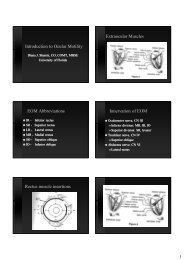1 Visual Acuity Testing CMSft. Lynn Lawrence, CPOT ... - SECO 2011
1 Visual Acuity Testing CMSft. Lynn Lawrence, CPOT ... - SECO 2011
1 Visual Acuity Testing CMSft. Lynn Lawrence, CPOT ... - SECO 2011
You also want an ePaper? Increase the reach of your titles
YUMPU automatically turns print PDFs into web optimized ePapers that Google loves.
� Motivation<br />
� Intelligence<br />
Stereo <strong>Testing</strong><br />
� Should be done prior to visual acuity testing<br />
Amsler Grid<br />
� Tests the central 20 degrees (macula)<br />
� Each square subtends an angle of 1 0<br />
• Macular Degeneration<br />
• Diabetic Retinopathy<br />
Pseudoisochromatic Plates (PIP’s)<br />
� Ishihara<br />
• 14, 24, or 38 plates<br />
• Plate #1 can be read by anyone, even those with color defects<br />
� Hardy-Rand Ritter (HRR)<br />
• Screening test to separate those with defective color vision from those<br />
with normal color vision<br />
• Classifies the type of defect<br />
• Indicates the extent of the defect (mild, medium, strong)<br />
Farnsworth D-15<br />
� Used to separate medium and strong color defect vs. normal<br />
Color Vision <strong>Testing</strong> Environment<br />
� Well-lit room<br />
� Natural daylight, without direct sunlight<br />
� MacBeth Illuminant C lamp<br />
� Filtered tungsten halogen light source to provide the most accurate simulation of<br />
natural daylight<br />
<strong>Testing</strong> Procedures-Children<br />
� Allow child to trace the color with a Q-tip or paintbrush.<br />
� Do not allow the patient to touch the discs with their hands, as dirt and oil can<br />
discolor the plates.<br />
6




